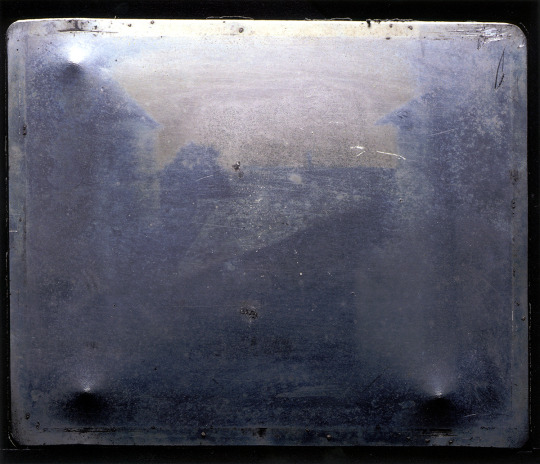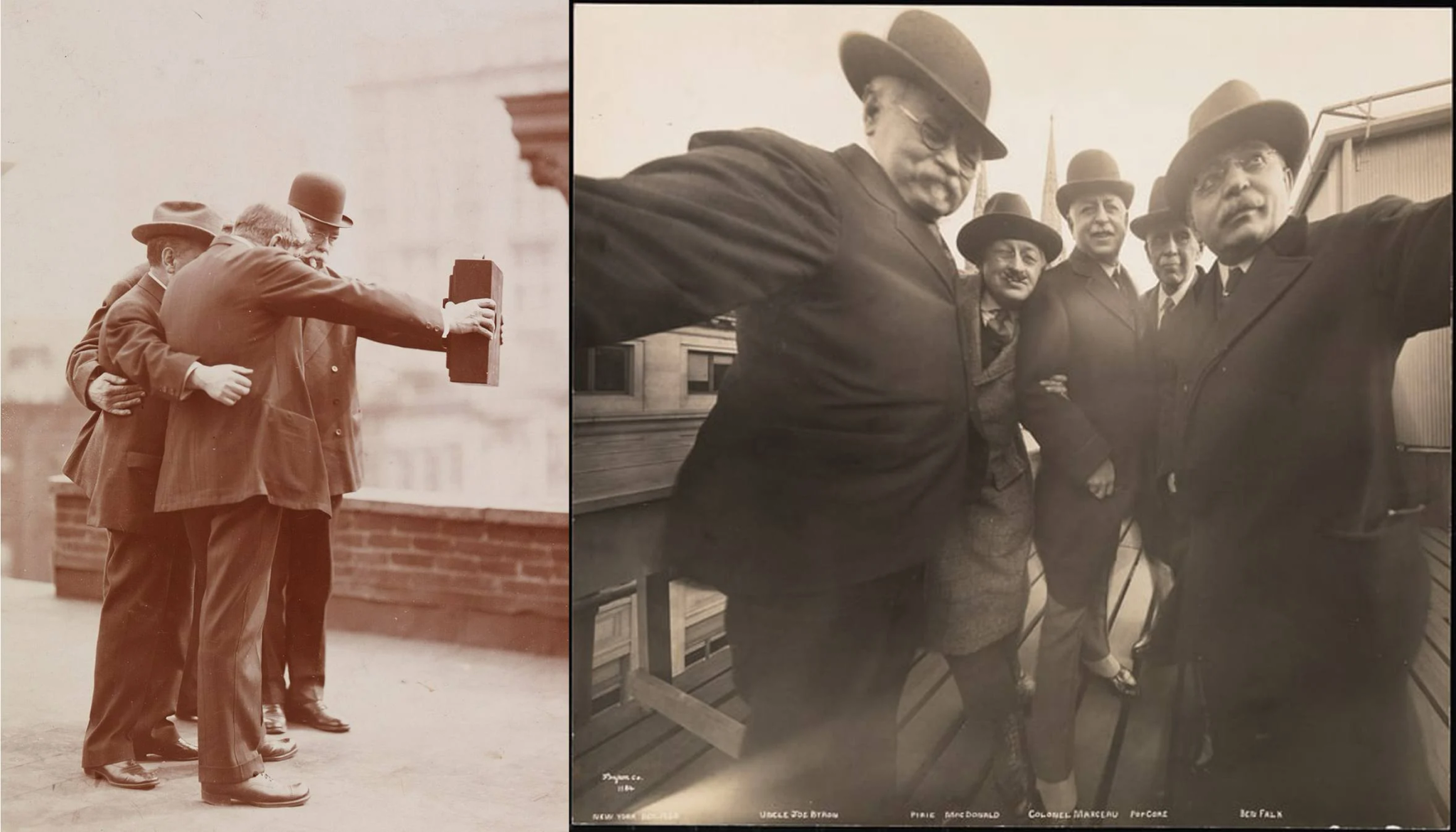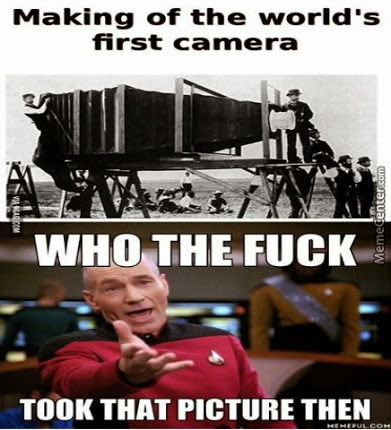First Successful Photograph Taken
by Nicéphore Niépce
in France
1826
Joseph Nicéphore Niépce
View from the Window at Le Gras (La cour du domaine du Gras) was the first successful permanent photograph, created by Nicéphore Niépce in 1826 at Saint-Loup-de-Varennes.
Niépce captured the photo with a camera obscura focused onto a sheet of 20 × 25 cm oil-treated bitumen.
It took 8
hours of exposure time.
As a result, it's why you can see sunlight both sides of
the building
Niépce's Heliograph (above) prior to restoration through the Helmut Gernsheim & Kodak Research Laboratory, March 21, 1952.
The pewter plate is identified as "G's Photograph".
The Gelatin silver print is 20.3 x 25.4 cm in size.
The pewter plate is identified as "G's Photograph".
The Gelatin silver print is 20.3 x 25.4 cm in size.
This
image is a reproduction print of gelatin silver and watercolor made
from the original photograph found in Niépce's possessions.
Above, see the photograph in it's original state.
Photograph
(above) by Paul Marillier using his model to obtain the correct window,
angle and date that the 'View From The Window At Le Gras' was taken.
Français: Nicéphore Niépce (1826 ou 1827). Vue de la fenêtre du domaine du Gras, à Saint-Loup-de-Varennes (Saône-et-Loire, Bourgogne, France).
Première photographie permanente jamais réalisée.
English: Enhanced version of Niépce's View from the Window at Le Gras, the first successful permanent photograph created by Nicéphore Niépce in 1826 or 1827, in Saint-Loup-de-Varennes (Saône-et-Loire, Bourgogne, France). Captured on 20×25 cm oil-treated bitumen. Due to the 8-hour exposure, the buildings are illuminated by the sun from both right and left.
Deutsch: J. N. Niépce (1826–1827). Blick aus dem Arbeitszimmer in Le Gras. 20×25 cm auf ölbehandeltem Asphalt. Durch die 8-stündige Belichtungszeit erscheinen die Gebäude sowohl rechter- als auch linkerhand sonnenbeschienen. Dieses Foto gilt allgemein als erstes der Welt.
Español: Vista de Le Gras desde una ventana primera fotografía permanente tomada con éxito por Nicéphore Niépce en 1826 o 1827, Saint-Loup-de-Varennes. 20×25 cm. Precisó de ocho horas de exposición.
Magyar: A Kilátás a dolgozószobából a legrégebbi fennmaradt fotográfia, melyet Nicéphore Niépce készített Saint-Loup-de-Varennes-ben (Saône-et-Loire, Bourgogne, France), saját dolgozószobájának ablakából, feltehetően 1826-1827 nyarán.
Русский: Вид из окна на Le Gras, первая из фотографий, созданная Нисефором Ньепсом в 1826-1827 году, Сен-Лу-де-Варенн (Saône-et-Loire, Bourgogne, France). Использовалась пластина, сделанная из сплава олова со свинцом и покрытая асфальтом. Размер 20 × 25. Из-за 8-часовой экспозиции, здания освещаются солнцем справа и слева.
Première photographie permanente jamais réalisée.
English: Enhanced version of Niépce's View from the Window at Le Gras, the first successful permanent photograph created by Nicéphore Niépce in 1826 or 1827, in Saint-Loup-de-Varennes (Saône-et-Loire, Bourgogne, France). Captured on 20×25 cm oil-treated bitumen. Due to the 8-hour exposure, the buildings are illuminated by the sun from both right and left.
Deutsch: J. N. Niépce (1826–1827). Blick aus dem Arbeitszimmer in Le Gras. 20×25 cm auf ölbehandeltem Asphalt. Durch die 8-stündige Belichtungszeit erscheinen die Gebäude sowohl rechter- als auch linkerhand sonnenbeschienen. Dieses Foto gilt allgemein als erstes der Welt.
Español: Vista de Le Gras desde una ventana primera fotografía permanente tomada con éxito por Nicéphore Niépce en 1826 o 1827, Saint-Loup-de-Varennes. 20×25 cm. Precisó de ocho horas de exposición.
Magyar: A Kilátás a dolgozószobából a legrégebbi fennmaradt fotográfia, melyet Nicéphore Niépce készített Saint-Loup-de-Varennes-ben (Saône-et-Loire, Bourgogne, France), saját dolgozószobájának ablakából, feltehetően 1826-1827 nyarán.
Русский: Вид из окна на Le Gras, первая из фотографий, созданная Нисефором Ньепсом в 1826-1827 году, Сен-Лу-де-Варенн (Saône-et-Loire, Bourgogne, France). Использовалась пластина, сделанная из сплава олова со свинцом и покрытая асфальтом. Размер 20 × 25. Из-за 8-часовой экспозиции, здания освещаются солнцем справа и слева.
'View from the Window at Le Gras' c. 1826.
Photo by J. Paul Getty Museum.


1826: Inventors of photography
1826: First photography
1826: First photography
THE first photograph was made by French inventor Joseph Nicéphore Niépce after years of experimenting to produce a permanent image from a camera.
Within a century, millions of people owned cameras.
The ancestor of the modern camera is the camera obscura, the earliest of which were small, dark rooms with a small hole to let in light.
The image of the scene outside the room would form on its back wall, upside down.
From the 16th century, artists used camera obscuras to help produce lifelike images that they would trace around. Portable versions were eventually made.
Niépce (1765–1833) wanted somehow to ‘fix’ the image the camera obscura produced and began trying out various chemicals to achieve it.
He succeeded with a petrochemical called ‘bitumen of Judea’, spread on to a pewter plate.
His earliest surviving photograph, on our spoof Sun front page (above right), needed an estimated eight-hour exposure to bright sunlight to produce.
Niépce called the process ‘heliography’, meaning ‘sun writing’.
From 1829, he worked with another Frenchman, Louis Daguerre (1787–1851), to try to improve the technique.
The two experimented with other substances, including silver.
Niépce died in 1833 and Daguerre continued the research.
By 1838, he had perfected the ‘daguerreotype’, an image formed on a silver-plated copper sheet.
Before a picture was taken, the silver surface was ‘sensitised’, by exposure to iodine vapour. This formed a light-sensitive compound called silver iodide.
After the picture was taken, the image was developed and then fixed using various chemicals. This was the first commercially available photographic technology.
Britain’s pioneer of photography was William Henry Fox Talbot (1800–1877), who carried out his first experiments at the same time as Daguerre.
Like Daguerre’s process, Talbot’s ‘calotype’ system exploited the fact that compounds of silver produce tiny granules of pure silver when exposed to light.
Talbot’s images were produced as ‘negatives’ on paper, and multiple ‘positive’ copies could be printed from each one.
Both these methods were clumsy and complicated.
New developments focussed on more convenient ways to attach the silver compounds to photographic plates, and on reducing exposure times.
The most successful was invented in the 1870s by Richard Maddox (1816–1902) and used gelatin to bind the silver compound to the plate.
Gelatin is still used in most camera film today.
Until the late 1880s, photography was largely in the hands of professionals who would buy or prepare their own photographic plates and develop the images themselves.
In 1884, American inventor George Eastman (1854–1932) pioneered the use of film on rolls, first with paper and from 1889 with celluloid.
Eastman started the Kodak company, which brought photography to ordinary people with its Brownie camera (1900).
The first commercially successful technology for taking colour photographs was the autochrome process – colour photographs made on glass.
The first colour film, celluloid with layers of emulsion sensitive to different colours, was available in the 1930s.
Sixty years later the digital photography revolution began, with images captured as electrical signals instead of a collection of silver granules.
The advantages of digital cameras are the convenience of being able to see and print an image immediately, of being able to delete sub-standard ones (instead of having to wait until they are developed) and of being able to catalogue and store pictures electronically.
The early years of the 21st Century saw the development of smartphones containing digital cameras capable of taking high-resolution pictures.
But some photographers keep faith with film cameras, claiming image quality is superior.
1826
- Earliest Extant Photograph? "View from the Window at Le Gras".
Joseph Nicephore
Niépce is credited with producing the world's first permanently
captured "image", which he called a Heliograph
(or Sun Drawing). Niépce's photograph (above)
was made in 1826 and was taken from a window looking out across
the roof tops of the Niépce home. He used a pewter plate that
was sensitized with bitumen of Judea. The photograph was made
in a camera obscura and took an eight -hour exposure. The extant
photograph is 8" x 6.5" and resides at the Harry Ransom Humanities
Research Center, The University of Texas at Austin. It was discovered
by chance, in March of 1952 in London when found along with letters
written by Niepce. The photograph is part of the Gernsheim Collection
and is known as “View From The Window At Le Gras”.
In 1813, Niépce obtained an image but it was not fixed, and eventually
faded. (Image Source: the Gernsheim
Collection, Ransom Centre, University
of Texas, Austin), (Thanks to Robert Carter, Photographic Historical
Society of Canada).
Joseph Nicéphore Niépce
(1765-1833)
Pioneer Photographer
Joseph Niépce was born on 7th March 1765 in Chalon-sur-Saône, France, the son of a wealthy landowner who had served as a King's Counsellor and a Royal Tax Collector. At school, Joseph developed a strong interest in physics and chemistry and in adult life he became an amateur scientist and inventor. In his early twenties, Niépce dropped his biblical Christian name of Joseph and adopted Nicéphore as a first name. ( The name Nicéphore was derived from the Greek words nike phoreo meaning "Victory Bearer" ). After serving as an officer in the French Revolutionary Army, Nicéphore Niépce returned home in 1801 to manage the family estate at Chalon-sur-Saône with his elder brother Claude. Since the mid 1790s, Nicéphore and Claude Niépce had been working together, conducting scientific experiments and inventing various machines, including a type of internal combustion engine, which the two brothers eventually patented in 1807.
During a visit to Sardinia in 1797, Nicéphore Niépce and his brother Claude discussed the idea of capturing images of nature through the agency of light. Around 1816, on his estate in Chalon-sur-Saône, Nicéphore Niépce began his first serious experiments in photochemistry. Using a specially made camera, Niépce managed to produce an image on sensitized paper, but he was unsuccessful in permanently fixing the resulting negative. After attempts to make positive pictures by contact printing from the negatives, Niépce abandoned the idea of using negatives and concentrated instead on creating positive images inside a camera.
In the early 1820s, because of his interest in lithography (printing from images fixed on stone), Nicéphore Niépce began experimenting with a resinous substance called "bitumen of Judea", a kind of asphalt. For Niépce, bitumen of Judea had particular properties which would prove useful in the production of positive images - bitumen of Judea hardened when exposed to light and as it hardened the bitumen turned pale grey. Niépce also discovered that any of the bitumen material which was unexposed could be dissolved in lavender oil and then washed away.
In his early experiments with bitumen of Judea, Niépce used the light sensitive properties of the substance to reproduce line drawings and engravings. He would dissolve the bitumen of Judea in lavender oil and then coat a glass plate with the mixture. A line drawing or engraving on paper would be made translucent with oil and then placed face down on the specially coated glass. The picture on the glass plate was then exposed to strong sunlight. Where the light shone through the blank areas of the picture, the bitumen hardened. The dark lines of the drawing or engraving shielded the areas of the sensitized plate below and the mixture in these parts remained soft. The soft, soluble areas of the coating could be then washed away with lavender oil, leaving a positive image behind. Niépce realised that by basically using the same process, he could produce a positive image inside a camera.
The First Photograph of a Human
"Boulevard Du Temple"
Paris, 1838
Boulevard du Temple, taken by Louis Daguerre in late 1838, was the first-ever photograph of a person. It is an image of a busy street, but because exposure time was over ten minutes, the city traffic was moving too much to appear.
The exception is a man in the bottom left corner, who stood still getting his boots polished long enough to show up in the picture
*The First Light Picture and Human Potrait Ever Taken
Oct,Nov 1839
Robert Cornelius, self-portrait, Oct. or Nov. 1839
approximate quarter plate daguerreotype which is a procedure invented in 1839 using silver on a copper plate. The back reads, “The first light picture ever taken.” This self-portrait is the first photographic portrait image of a human ever produced



No comments:
Post a Comment